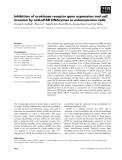
Cancer cell biology and angiogenesis
-
The urokinase-type plasminogen activator (uPA) receptor (uPAR) has been implicated in signal transduction and biological processes including cancer metastasis, angiogenesis, cell migration, and wound healing. It is a specific cell surface receptor for its ligand uPA, which catalyzes the formation of plasmin from plasminogen, thereby activating the proteolytic cascade that contributes to the breakdown of extracellular matrix, a key step in cancer metastasis.
 11p
11p  fptmusic
fptmusic
 11-04-2013
11-04-2013
 46
46
 3
3
 Download
Download
CHỦ ĐỀ BẠN MUỐN TÌM













